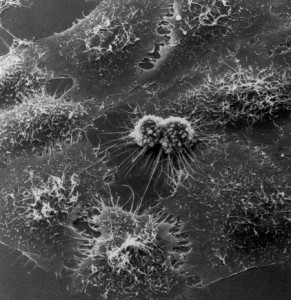Written by Henry Heng, Co-Editor-in-Chief of Molecular Cytogenetics
Privacy and ethical concerns about the publication of the HeLa cell genome sequence have generated a great deal of commentary. In addition to a number of pieces from well-known scientific journals (1-2), the New York Times has also joined this interesting discussion (3).
Today, regulations require informed consent to be obtained prior to establishing a cell line from an individual. How do we treat HeLa cells that originally were established 62 years ago and without a consent? Who should claim the ownership of the cell lines, the original patient or the researchers who experimentally manipulated and selected the specific cell lines? Perhaps both parties could claim the ownership, if any.
 While interesting, debates such as this seem to miss one fundamental scientific issue. The present HeLa genome, or any other HeLa genomes, while derived from Henrietta Lacks’s genome is not her personal genome. There is no doubt that the majority of DNA sequences are identical between HeLa cells and Lacks’ original cells.
While interesting, debates such as this seem to miss one fundamental scientific issue. The present HeLa genome, or any other HeLa genomes, while derived from Henrietta Lacks’s genome is not her personal genome. There is no doubt that the majority of DNA sequences are identical between HeLa cells and Lacks’ original cells.
However, HeLa cell genome and Lacks’s genome show very little similarity. Lacks’ genome originally contained 46 normal chromosomes while most HeLa cells have 70-90 chromosomes with over 20 translocations, some of which are highly complex involving multiple chromosomal rearrangements.
To fully appreciate this point, one has to understand and define what the genome is. The genome is not just a collection of genes, arranged like pearls in a string. While individual genes produce functional parts or proteins, the genome structure has a function defined by the karyotype that provides the blueprint that describes how these parts work together (4-5).
In other words, the genome defines the network structure by providing the “system inheritance”. It is the karyotype rather than DNA sequence that defines the identity of the cell line as different derived cell lines could have similar sequences but different karyotypes (or genome context). This concept has recently been illustrated by re-interpretation the main function of sex, and the importance of the karyotype.
It turns out, karyotype rather than specific genes define the identity of the species (6-8). In the case of the HeLa genome, the changes generated over the past few decades have occurred through multiple runs of genome re-organization during cancer evolution and initial cell culture experimentations.
These changes not only differ greatly from Lacks’s original genome but it can be argued that the HeLa genome is not actually a human genome anymore. In fact, some evolutionary biologists consider cancer cell such as HeLa cells to be their own unique species (see works of Julian Huxley and Leigh Van Valen).
In recent years, an increase of investigators including our own group have proposed/supported the notion that many cancer cells are no longer “human cells,” as judged by karyotypic changes (for more information, please check out our references on genome theory) (9-12).
Yes, many DNA sequences in cancer cells are still the same as compared to their original human cells, but if we are only judging by DNA sequence similarity, the same can be said to cells from other species. Most eukaryotic species are defined by their unique karyotypes (despite sharing similar genes), demonstrating the importance of the genome, which is to organize similar genes to define the inheritance of each species.
Despite the fact that cancer cells are derived from normal somatic cells, they form newly emergent systems. The process of cancer evolution is punctuated, and its products cannot reform the original genome structure. Without a fixed cancer genome, the DNA sequence and karyotype profiles of dynamic cancer cell populations are so divergent from their original hosts that there should be little concern for privacy or ownership issues.
Further Reading:
- Callaway E, Deal done over HeLa cell line, Nature 500, 132-133 (2013).
- Heng HH, HeLa genome versus donor’s genome, Nature 501, 167 (2013).
- Zimmer C, A Family Consents to a Medical Gift, 62 Years Later. The New York Times, 7 Aug, 2013. https://www.nytimes.com/2013/08/08/science/after-decades-of-research-henrietta-lacks-family-is-asked-for-consent.html?pagewanted=all
- Heng HH et al, Decoding the genome beyond sequencing: The new phase of genomic research, Genomics 98, 242-252 (2011). PubMed
- Heng HH, The genome-centric concept: resynthesis of evolutionary theory, Bioessays 31, 512-525 (2009). PubMed
- Heng HH, Elimination of altered karyotypes by sexual reproduction preserves species identity, Genome 50, 517-524 (2007).
- Wilkins AS, and Holliday R, The evolution of meiosis from mitosis. Genetics 181:3–12 (2009).
- Gorelick R and Heng HH, Sex reduces genetic variation: a multidisciplinary review, Evolution 65, 1088-1098 (2011). PubMed
- Ye CJ et al, The dynamics of cancer chromosomes and genomes, Cytogenet Genome Res 118, 237-246 (2007). PubMed
- Heng HH et al, Evolutionary mechanisms and diversity in cancer, Adv Cancer Res 112, 217-253 (2011). PubMed
- Duesberg P et al, Is carcinogenesis a form of speciation? Cell Cycle, 10:2100-14 (2011).
- Vincent MD, Cancer: beyond speciation. Adv Cancer Res 112, 283-350 (2011).
Note: I appreciate the discussions with my colleagues Markku Kurkinen, Steve Bremer, Joshua Stevens and Steve Horne.
- Raising funds for genetic diseases - 23rd September 2016
- The Epigenetics and Chromatin Clinic - 9th November 2015
- Resurrecting one of the oldest genetics journals - 23rd October 2015
2 Comments